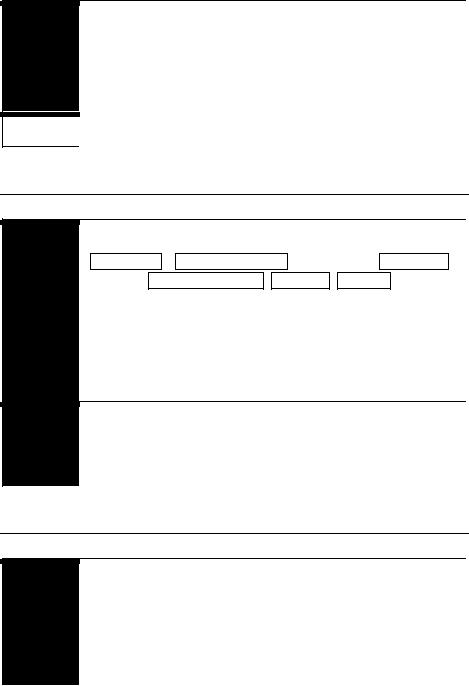
LAW / Referencing for Law Students / AGLC 3rd ed
.pdf
|
|
|
Australian Guide to Legal Citation |
59 |
|
|
|
|
|
|
|
|
• the initials or first names of tribunal members should |
be |
|
|
|
||
|
|
|
omitted, unless they are necessary to avoid ambiguity (in |
|
|
|
|
accordance with rule 1.14.4). |
|
|
|
|
|
|
|
|
|
||
|
|
Re Pochi and Minister for Immigration and Ethnic Affairs (1979) 26 |
||
|
Examples |
|
||
|
|
|
ALR 247. |
|
|
|
|
McMahon v Boorondara City Council [2002] VCAT 626 (5 July |
|
|
|
|
2002) [26]–[28] (Member Avery). |
|
|
|
|
Application by AAPT Ltd [No 2] [2009] ACompT 6 (9 September |
|
|
|
|
2009) [6.1]–[6.5] (Finkelstein J, Member Davey and Prof Round). |
|
|
|
|
Dr Gerber stated: |
|
|
|
|
when dealing with rugby footballers, it seems to me to be a fruitless |
|
|
|
|
exercise to parse and analyse their every utterance in an attempt to |
|
|
|
|
comprehend their meaning. In the hands of rugby league footballers, the |
|
|
|
|
spoken word — like the game itself — is rough at the best of times …21 |
|
|
|
|
__________ |
|
|
|
|
21 AAT Case 7422 (1991) 22 ATR 3450, 3456 [28]. He later |
|
|
|
|
commented (at 3458 [45]) that: |
|
|
|
|
Whatever the capital gains tax provisions sought to achieve is still |
|
|
|
|
firmly locked in the mind of the parliamentary draftsman who, for |
|
|
|
|
purposes of comprehension and enlightenment, might as well have |
|
|
|
|
enacted Pt IIIA in Swahili. |
|
|
|
|
||
|
Note |
|
Administrative decisions are often reported in the ALD, ATR and state |
|
|
|
|||
|
|
|
administrative decision series. Many administrative tribunals have |
|
|
|
|
||
medium neutral unique ‘court’ identifiers, some of which are listed in Table A.
2.11.2Arbitrations
Rule |
Arbitral decisions should be cited as follows: |
|
|
Case Name ( Award Description , Forum , Case/Award No # ,
Full Date ) Pinpoint .
Cases

60 Part II — Domestic Sources
Only information appearing on the arbitral decision should be included. If the parties’ names are omitted from an arbitral decision, the other elements should be included but should not appear in parentheses. ‘Case/Award’ should be replaced by the appropriate designation used by the relevant forum. If there is no forum, the arbitrator’s name may be included instead.
Where the parties’ names are included, there should be no punctuation between the closing parenthesis after the full date and any pinpoint. If the parties’ names are not included, a comma should separate the full date and any pinpoint. Pinpoint references should be to pages, paragraphs or both (and should adhere to rules 1.1.5–1.1.6).
Where an arbitral decision is reproduced in a report series, book or periodical, a citation to the reproduction should be included after the above information, preceded by ‘reported in’. A starting page should be included. Pinpoints should be to the page numbers of the reproduction, and may also include paragraph numbers in addition.
Examples Sandline International Inc v Papua New Guinea (Award, Sir Edward Somers, Sir Michael Kerr and Sir Daryl Dawson, 9 October 1998) [10.2].
Beckman Instruments Inc v Overseas Private Investment Corporation
(Award and Opinion, American Arbitration Association Commercial Arbitration Tribunal, Case No 16 199 00209 87G, 20 February 1988) reported in (1988) 27 ILM 1260, 1263.
Meiki Co Ltd v Bucher-Guyer SA (Preliminary Award, International Chamber of Commerce, Case No 2114 of 1972, 10 October 1972) reported in Sigvard Jarvin and Yves Derains (eds), Collection of ICC Arbitral Awards: 1974–1985 (Kluwer, 1990) 49, 51.
Final Award, Netherlands Arbitration Institute, Case No 1930, 12 October 1999 reported in (2001) 26 Yearbook — Commercial Arbitration 181, 184 [5]–[6].

Australian Guide to Legal Citation |
61 |
2.12Transcripts of Proceedings
2.12.1General Rule
Rule |
Transcripts of proceedings should be cited as follows: |
|
|
Transcript of Proceedings, Case Name ( Court ,
Proceeding Number , Judge(s) , Full Date of Proceedings )
Pinpoint .
A proceeding number (the number assigned by the court to the matter) should be included only if it appears on the transcript. The names of all judges hearing the matter should be included after the proceeding number.
Pinpoint references should be to page numbers or line numbers (where line numbering is continuous across a transcript). If a pinpoint is included, a speaker’s name may be included after it (in accordance with rules 2.9.1–2.9.2) but ‘(in argument)’ should not be included.
Examples Transcript of Proceedings, Celano v Swan (County Court of Victoria, 09/0867, Judge Lacava, 27 August 2009) 11 (S M Petrovich).
Transcript of Proceedings, R v MSK (Supreme Court of New South Wales, Hidden J, 18 May 2005) 112, 143, 151, 156.
2.12.2High Court of Australia from July 2003
Rule Transcripts of proceedings in the High Court of Australia with ‘HCATrans’ numbers appearing on the transcript itself should be cited as follows:
Transcript of Proceedings, Case Name [ Year ] HCATrans Number
( Full Date of Proceedings ) Pinpoint .
Pinpoint references should be to line numbers. If a pinpoint is included, a speaker’s name may be included after it (in accordance with rules 2.9.1–2.9.2), but ‘(in argument)’ should not be included.
Transcripts of other High Court proceedings should be cited according to rule 2.12.1.
Cases

62 Part II — Domestic Sources
Examples Transcript of Proceedings, Ruhani v Director of Police [2005] HCATrans 205 (19 April 2005).
Transcript of Proceedings, Mulholland v Australian Electoral Commission [2004] HCATrans 8 (12 February 2004) 2499–517 (Callinan J and J B R Beach QC), 2589–93 (McHugh J).
Note |
High Court transcripts contain ‘HCATrans’ numbers from July 2003. |
|
|
2.13Submissions in Cases
Rule
Example
Submissions in cases should be cited as follows:
Party Name , ‘ Title of Submission ’, Submission in Case Name , Proceeding Number , Full Date , Pinpoint .
A title of submission and a proceeding number (the number assigned by the court to the matter) should be included only if they appear in the submission.
Pinpoints may be to page numbers, paragraph numbers or both (see rules 1.1.5–1.1.6).
Attorney-General (Cth), ‘Outline of Submissions of the Attorney-General of the Commonwealth as Amicus Curiae’, Submission in Humane Society International Inc v Kyodo Senpaku Kaisha Ltd, NSD 1519/2004, 25 January 2005, [10], [20]–[22], [28].
2.14Subsequent References
Rule ‘Ibid’ should be used for all materials in this chapter (in accordance with rule 1.4.1).
In other subsequent references, citations should appear in full each time a source is referred to. However, for citations to cases and quasijudicial decisions a short title may be used in place of the parties’ names (in accordance with rule 2.1.14).

Australian Guide to Legal Citation |
63 |
‘Above n’ should not be used for any materials in this chapter.
Examples 14 Moore v Haynes (2008) 23 NTLR 112, 116–17 [19]–[20] (‘Moore’).
15 Ibid 118 [24].
…
19Moore (2008) 23 NTLR 112, 121 [34]. [Not: Moore, above n 14, 121 [34].]
20Transcript of Proceedings, NV Philips Gloeilampenfabrieken v Mirabella International Pty Ltd (High Court of Australia, No S73 of 1994, Mason CJ, 23 November 1994) 3 (R J Ellicott QC).
21Ibid (Mason CJ). His Honour commented that it would ‘be a sacrifice’ not to hear counsel’s arguments.
Cases

64
3 Legislative Materials
3.1Statutes (Acts of Parliament)
|
Example |
Crimes Act |
1958 |
(Vic) |
s 3 |
|
|
|
|
|
|
|
Element |
Title |
Year |
Jurisdiction |
Pinpoint |
|
|
|
|
|
|
|
Rule |
3.1.1 |
3.1.2 |
3.1.3 |
3.1.4–3.1.6 |
|
|
|
|
|
|
3.1.1Title
Rule
A citation to an Australian Act of Parliament should begin with the short title of the Act in italics. The long title of the Act should be used only if the Act does not contain a short title.
Titles should appear as they do in the statute book, subject to chapter 1. In particular:
•punctuation should adhere to rule 1.6.1 (so full stops should not be used in abbreviations); and
•capitalisation should adhere to rule 1.7.
Where multiple Acts have the same title but contain different numbers in their short titles (for example, ‘(No 1)’ and ‘(No 2)’), the number should be included and should appear in parentheses.
Examples
Note
Evidence Act 1995 (NSW).
Social Welfare Ordinance 1964 (NT).
Law and Justice Legislation Amendment Act (No 2) 1992 (Cth).
Law and Justice Legislation Amendment Act (No 4) 1992 (Cth).
Statutes of the Australian Capital Territory and the Northern Territory were previously referred to as ordinances. However, these ordinances became known as Acts after the ACT (in 1988) and the NT (in 1978) attained self-government.

Australian Guide to Legal Citation |
65 |
3.1.2Year
Rule The year in which the Act was originally passed should appear in italics following the title. The year should be included whether or not the Act includes it in the short title.
Example Meteorites Act 1973 (Tas). [Not: Meteorites Act 1973 (Tas).]
Note Citations to an Act refer to the Act as amended (and consolidated). Regardless of when a particular provision was introduced, the year included should be that of original enactment. Generally, a principal Act rather than an amending Act should be cited (but see rule 3.8).
For the ACT and the NT, the year is that in which the original ordinance (which may subsequently have become an Act) was enacted.
3.1.3Jurisdiction
Rule An abbreviated form of the jurisdiction in which the Act was passed should appear in parentheses following the year. The jurisdiction should not be italicised.
The following abbreviations should be used for Australian jurisdictions:
|
Jurisdiction |
Abbreviation |
|
|
|
||
|
|
|
|
|
Commonwealth |
Cth |
|
|
Australian Capital Territory |
ACT |
|
|
New South Wales |
NSW |
|
|
Northern Territory |
NT |
|
|
Queensland |
Qld |
|
|
South Australia |
SA |
|
|
Tasmania |
Tas |
|
|
Victoria |
Vic |
|
|
Western Australia |
WA |
|
|
|
|
|
Examples Misrepresentation Act 1972 (SA).
Charter of Human Rights and Responsibilities Act 2006 (Vic).
Legislative
Materials

66 Part II — Domestic Sources
3.1.4Pinpoint References
Rule Pinpoint references to Acts usually comprise an abbreviation and a number, separated by a space.
Pinpoint references should use the following abbreviations (in the text and in citations), except where the pinpoint begins a sentence:
Designation |
|
Abbreviation |
|
Plural |
Abbreviation |
|
|
|
|
|
|
Appendix |
|
app |
|
Appendices |
apps |
Article |
|
art |
|
Articles |
arts |
Chapter |
|
ch |
|
Chapters |
chs |
Clause |
|
cl |
|
Clauses |
cls |
Division |
|
div |
|
Divisions |
divs |
Paragraph |
|
para |
|
Paragraphs |
paras |
Part |
|
pt |
|
Parts |
pts |
Schedule |
|
sch |
|
Schedules |
schs |
Section |
|
s |
|
Sections |
ss |
Sub-clause |
|
sub-cl |
|
Sub-clauses |
sub-cls |
Subdivision |
|
sub-div |
|
Subdivisions |
sub-divs |
Sub-paragraph |
|
sub-para |
|
Sub-paragraphs |
sub-paras |
Subsection |
|
sub-s |
|
Subsections |
sub-ss |
The word ‘item’ may be used to refer to an item in a table or schedule, or a numbered paragraph in an amending Act. It should not be abbreviated.
Numbered or lettered subsections should be placed in parentheses immediately following the section number. The section number and subsection number should not be separated by a space (for example, ‘s 3(a)’, not ‘s 3 (a)’).
In references to a section and a subsection, a paragraph and a sub-paragraph, etc, the abbreviation that corresponds to the highest ‘level’ of the section or paragraph etc in the pinpoint should be used (for example, ‘s 31(1)’, not ‘sub-s 31(1)’).
Where multiple combinations of an abbreviation and a number are needed to form one pinpoint reference, there should be no comma between each abbreviation–number combination (for example, ‘pt III div 2’, not ‘pt III, div 2’).

Australian Guide to Legal Citation |
67 |
Where an Act uses a decimal numbering system (often in the form Chapter . Part . Section ), pinpoints should contain the whole of the decimal number preceded by the abbreviation for the lowest ‘level’ of section, part, chapter, etc, cited (for example, ‘s 2.3.5’, not ‘ch 2.3.5’).
Examples |
s 2 |
s 108 |
sub-s (3) |
|
pt V |
s 5(1) [Not: s5(1)] |
s 2(3) [Not: s 2 (3)] |
|
ch III |
s 14(1)(a) |
s 28(1)(a)(i) |
|
pt 7 div 3 sub-div 8 |
s 13 [Not: pt 2 s 13] |
cl 14(3)(a) |
Despite there being no requirement to show fault, actions under Trade Practices Act 1974 (Cth) pt VA have been rare.
She drew attention to sub-s (1). Subsection (1) provides that ‘a registered trade mark is personal property.’
The judge referred to s 8(3) in argument. [Not: … sub-s 8(3) …]
Social Security (Administration) Act 1999 (Cth) s 123TE.
Aboriginal and Torres Strait Islander Act 2005 (Cth) pt 3A div 2.
Civil Liability Act 2003 (Qld) ch 2 pt 1 div 4.
Crimes at Sea Act 1999 (Vic) sch 1 cl 2.
Aboriginal Land Rights (Northern Territory) Amendment Act 2006
(Cth) sch 1 item 46.
A New Tax System (Goods and Services Tax) Act 1999 (Cth) s 38-10(1) item 2.
Gambling Regulation Act 2003 (Vic) s 3.2.1.
Legal Profession Act 2004 (Vic) pt 2.3.
Income Tax Assessment Act 1997 (Cth) s 20-110(1)(a).
Notes The most specific pinpoint that is appropriate should be included. Thus ‘pt 3 div 7’ is appropriate where speaking generally of that division, but ‘s 58’ is appropriate where dealing with an individual section. Because section numbering is usually continuous throughout an Act, it is unnecessary to indicate chapters, parts, divisions, etc, when citing a section.
Legislative
Materials

68 Part II — Domestic Sources
Some recent taxation statutes contain sections in the form of a division number immediately followed by a hyphen and a section number (for example, ‘s 26-52(6)(c)’). A hyphen (not an en-dash) should be used in such pinpoints.
3.1.5Multiple Pinpoint References
|
Rule |
|
The plural abbreviation of the highest ‘level’ of sections, subsections, |
||
|
|
|
etc, cited should precede multiple pinpoints (see rule 3.1.4). |
||
|
|
|
Consecutive pinpoints should appear separated by an en-dash (–) (for |
||
|
|
|
example, ‘sub-ss (2)–(3)’). Hyphens (-) should not be used (in |
||
|
|
|
accordance with rule 1.1.6). |
|
|
|
|
|
Non-consecutive pinpoints should be separated by commas (for |
||
|
|
|
example, |
‘paras (3), (5)’). The word ‘and’ should not be used to |
|
|
|
|
separate the final two pinpoints (in accordance with rule 1.1.5). |
||
|
|
|
Spans of section numbers should adhere to rule 1.12.1. In spans of |
||
|
|
|
alphanumeric sections, divisions, parts, etc, of an Act, the whole |
||
|
|
|
section number should be repeated (for |
example, ‘ss 22A–22D’, |
|
|
|
|
not ‘ss 22A–D’). |
|
|
|
|
|
Where an Act uses a decimal numbering system, each section, part, |
||
|
|
|
etc, number in spans and in non-consecutive pinpoints should be |
||
|
|
|
written out in full. |
|
|
|
|
|
|
|
|
|
Examples |
|
ss 2–3 |
ss 42–9 |
ss 5–6, 9–11 |
|
|
||||
|
|
|
ss 6(7)(b)–(d) [Not: s 6(7)(b)–(d)] |
sub-ss (2)–(7) |
|
|
|
|
|||
|
|
|
ss 29(2)–(5) [Not: sub-ss 29(2)–(5)] |
sub-paras (4)–(8) |
|
|
|
|
ss 3(a)–(c) [Not: ss 3(a), (b), (c)] |
cls (1)–(3) |
|
|
|
|
ss 92(1), (4), (7) [Not: ss 92(1), (4) and (7)] |
divs 3–4 |
|
|
|
|
ss 8(2), (5)(a)–(b) [Not: ss 8(2), 8(5)(a)–(b)] |
ss 5, 7, 9, 28 |
|
HSI, as an ‘interested person’, sought a declaration and injunction against Kyodo for contravening ss 229–30 of the Environment Protection and Biodiversity Conservation Act 1999 (Cth).
Unpublished works are dealt with in sub-ss (2)–(3).
Liquor Act 2007 (NSW) ss 5(1)(a)–(b).
